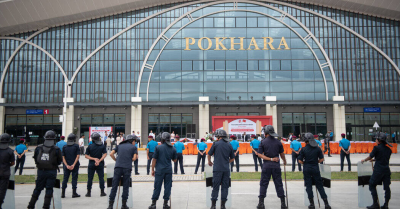纽约时报中文网 - 英文原版-英Nepal Is Investigating New Airport Made by China
November 12, 2023 5 min 927 words
这则报道揭示了尼泊尔对中国新建机场展开调查的新闻。中国在全球推动基建项目,但其质量和透明度一直备受争议。尼泊尔对这座新机场的调查可能反映了对中国基建项目的普遍担忧。报道未明示调查的具体原因,但或许是出于对工程质量、环保或债务等方面的担忧。中尼关系复杂,这一调查可能影响两国间的合作。这提醒国际社会,在中资基建背后需要更多透明度,同时也促使各国审慎对待与中国的合作,确保在合作中既获得实质好处,又不失去国家的独立性和长远利益。
As developing countries weigh the consequences of borrowing heavily from China for major infrastructure projects, anti-corruption officials in Nepal have begun an investigation into a flagship airport financed and built by Chinese state-owned companies.
Nepal’s $216 million international airport in Pokhara, the country’s second-biggest city, opened in January. China agreed to provide loans to build the airport more than a decade ago. Nepal tapped China CAMC Engineering, the construction arm of a state-owned conglomerate, Sinomach, as the contractor.
The airport has failed to attract any regular international flights, raising concerns about whether it will generate enough revenue to repay loans to its Chinese lenders. Nepali officials have asked Beijing to change the loans into a grant to ease the financial burden, but China has not agreed to do so.
Last month, The New York Times reported that CAMC had inflated the cost of the project and undermined Nepal’s efforts to maintain quality control, putting a priority on its own business interests. Nepal’s Civil Aviation Authority, the agency overseeing the airport’s construction, did not put up much resistance — reluctant to upset Beijing on an important project for both countries.
Shortly after the article’s publication, Nepal’s Commission for the Investigation of Abuse and Authority raided the Pokhara offices of the Civil Aviation Authority and seized documents related to the project.
Bhola Dahal, a spokesman for the anti-corruption agency, confirmed that an investigation into the airport was underway but declined to elaborate, noting that it was still in the preliminary stages. He said the agency had started the investigation in response to a complaint about irregularities with the project. He declined to say who filed the complaint. Local media reports said the agency had received more than 20 complaints about construction quality at the airport.
The investigation is the latest black eye for China’s overseas infrastructure projects, which face criticism for costly and poor-quality construction that leaves borrower countries awash in debt. Beijing has declared the Pokhara airport the “flagship project” of its Belt and Road Initiative with Nepal.
The Belt and Road Initiative, a signature campaign of President Xi Jinping of China, has handed out an estimated $1 trillion in loans and grants as part of Beijing’s efforts to build stronger economic and diplomatic ties around the world, while bolstering the lucrative infrastructure building business for its state-owned enterprises.
Nepal, one of the poorest countries in Asia, had sought to build an international airport in Pokhara since the 1970s in the hopes of turning the city into a tourist destination. The airport held a deep significance for Nepali officials, who hailed it as a “national pride” project because it was seen as a gateway to one of its most famous landmarks — the Himalayas.
Nepal’s anti-corruption agency is constitutionally empowered to investigate high-profile corruption cases and file charges at a special independent court. This year, in an unrelated case, a former government minister and a sitting member of Nepal’s Parliament were found guilty of corruption charges brought by the anti-graft body.
Jagannath Niroula, deputy director general at the Civil Aviation Authority, said anti-corruption investigators had spent two or three days in Pokhara looking into the airport’s construction quality.
A few engineers who had worked on the airport told investigators that building quality had been compromised and that the project’s infrastructure was not sound, said two people familiar with the investigation, who did not have permission to speak publicly on the matter.
In a statement, China’s Ministry of Foreign Affairs said it was not aware of an investigation into the airport, but noted that it had always required Chinese firms operating abroad to comply with local laws and regulations. The ministry said CAMC “strictly implemented quality standards and kept complete records during the construction process.” CAMC did not respond to requests for comment about the investigation.
There is a growing mistrust among countries struggling to repay debts to China. Sri Lanka was forced to hand over a deepwater port to China when it could not repay its loans. Around 30 percent of Pakistan’s foreign debt is owed to China, a figure that has climbed with the building of a $50 billion China-Pakistan Economic Corridor. In Malaysia, an $11 billion rail link was halted until a Chinese contractor agreed to slash the project’s costs.
The Pokhara airport is one of several Nepalese projects for the Belt and Road Initiative, which the country signed onto in 2017. China has agreed to finance a feasibility study for a cross-border railway that would be part of a so-called Trans-Himalayan connectivity network that may eventually include highways connecting the two countries. Nepal is also seeking Chinese assistance for a power transmission line that would cross the countries’ border.
But Nepal has rejected the designation of the airport as a Belt and Road project, because that label has complicated its diplomatic ties with India — its neighbor and rival to China for influence in the region. India, a major destination for Nepali travelers, has dragged its feet on approving flights to and from the airport.
Engineering consultants who worked on the airport told The Times that CAMC’s work did not meet international standards. The company completed earth-filling work for the runway but did not provide documentation that it had tested for soil density, meaning that Nepali officials did not have assurances that the foundation of the runway was built properly, according to Murari Gautam, an outside consultant brought on by Nepal’s aviation agency.

